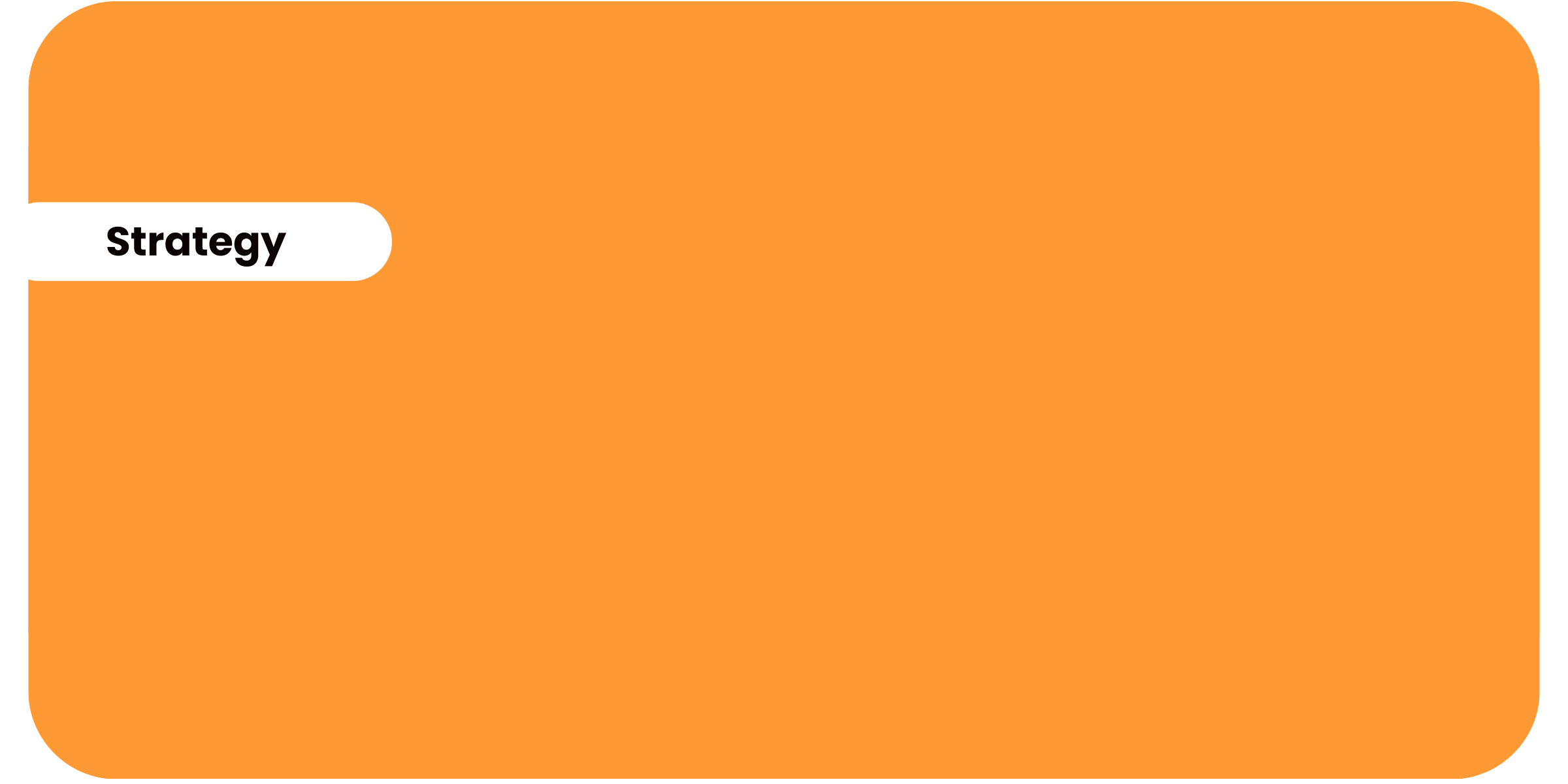Christmas Calendar Guide
Looking to turn the festive season into a high-performing marketing campaign? Online Christmas Calendars blend tradition with gamified engagement, making them a powerful tool for brand visibility, lead generation, and customer loyalty. In this guide, you’ll explore how to build one that not only delights your audience but also delivers real business results—with proven strategies, psychological insights, and success stories from brands like Toyota and Continental.
Table of contents
- Brief history of “Online Christmas Calendar”
- An exploration of Special formats and its psychological effect
- Use cases across different industries (eCommerce, Retail and Consumer Goods)
- Description of settings and configurations
- Implementation strategies
History of Online Christmas Calendar:
Traditional Origins (19th–20th Century):
The concept of Christmas calendars began in Germany in the 19th century as paper countdowns to Christmas Eve, often with images, poems, or small chocolates behind each door. By the mid-20th century, printed Advent calendars had become a widespread holiday tradition across Europe and North America.
Branded Physical Campaigns (1980s–2000s):
Retailers and consumer brands started adopting the format by producing branded Advent calendars filled with samples or product teasers. These physical campaigns helped brands stay top-of-mind throughout the holiday season, encouraging daily interaction and seasonal loyalty.
Digital Reinvention & Gamified Marketing (2010s–Present):
With advances in digital marketing, the Christmas Calendar transformed into an interactive online format. Modern campaigns now offer daily games, giveaways, or challenges that span 24 days in December. These digital calendars are widely used for:
- Daily customer re-engagement
- Loyalty building through habitual participation
- Lead generation and data capture
- Driving seasonal sales through exclusive offers
Today, online Christmas Calendars blend tradition and technology—creating festive, high-impact brand experiences that users look forward to each day.
Exploration of Special formats and its psychological effect
Christmas calendars are highly effective at driving engagement by leveraging human psychology. The daily unveiling of a new window sparks anticipation and releases dopamine, satisfying curiosity and creating a thrill of the unknown. This element of unpredictable reward is crucial for maintaining user interest.
Beyond surprise, the consistent daily interaction fosters habit formation. The repetition integrates the calendar into the user’s routine. Moreover, visual indicators of progress, such as streaks or countdowns, increase adherence by tapping into our desire to complete tasks. This motivation is a driving force behind successful calendar applications.
Finally, the emotional satisfaction of achieving a daily goal, even something as simple as reaching Day 24, contributes significantly. The accomplishment provided by these games distinguishes them from other experiences. Thus, the success of Christmas calendars is rooted in their strategic design, which skillfully employs psychological principles, rather than just their festive appeal.
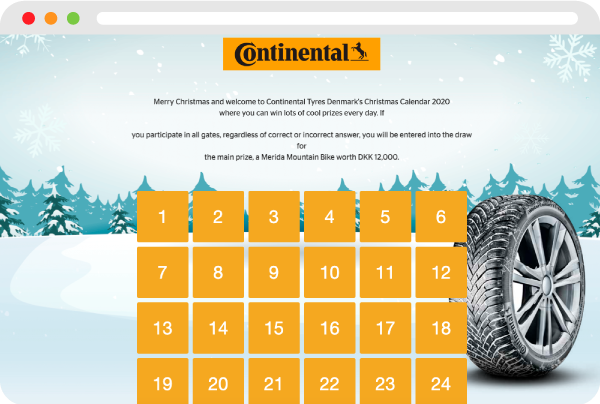
Use cases across industries:
E-Commerce: Continental’s Christmas Calendar
Continental, a major brand in the mobility space, launched a Christmas Calendar campaign that transformed everyday digital interactions into sales opportunities. By turning each calendar door into an engaging quiz tied to exclusive offers, the campaign achieved a 130% increase in newsletter subscribers and drove a significant boost in online conversions. The campaign got over 5 thousand unique visitors, showcasing strong engagement in a niche audience.
Retail: Toyota’s Holiday Engagement Campaign
Toyota’s holiday gamification campaign combined festive storytelling with interactive surprises to captivate its audience. The car manufacturer achieved a 97% conversion rate, proving that an immersive, holiday-themed experience can spark exceptional customer activation in the retail space. Toyota’s Christmas calendar achieved an average of 18 play-days per participant, showing that users didn’t just join once – they came back almost every day.
Technical description of settings and configurations:
Start by adding a Game Page to your campaign and selecting the Christmas Calendar format. Once placed, choose a layout that fits your campaign. You can pick from existing templates or create a new one from scratch to match your visual identity.
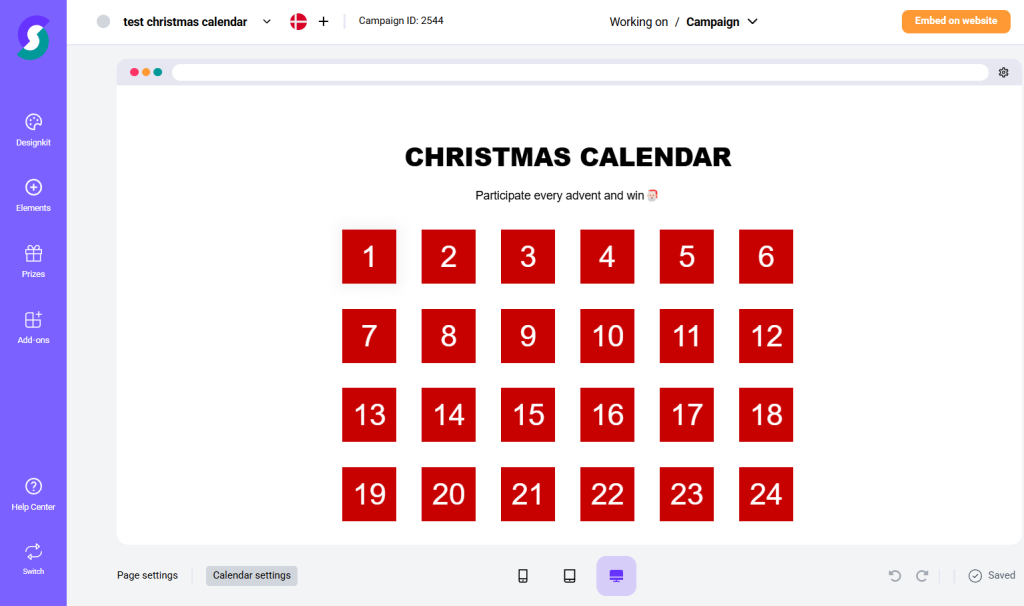
Then, choose the dates that should be displayed on the campaign, such as December 1–24. Now you can select the number of items per row, and content width. Additionally, it is possible to add an image behind the door(s). In the settings it is also possible to randomize the door order.
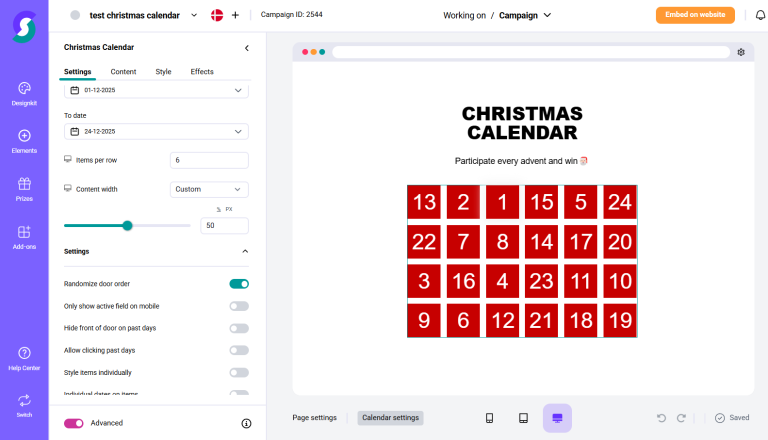
Once the structure is in place, it’s time to design the calendar doors. Each door can be styled with an image, text, or color—or a combination of these. You can also adjust the gap between the doors to create the spacing you want, and define how the calendar should appear on desktop, tablet, and mobile devices.
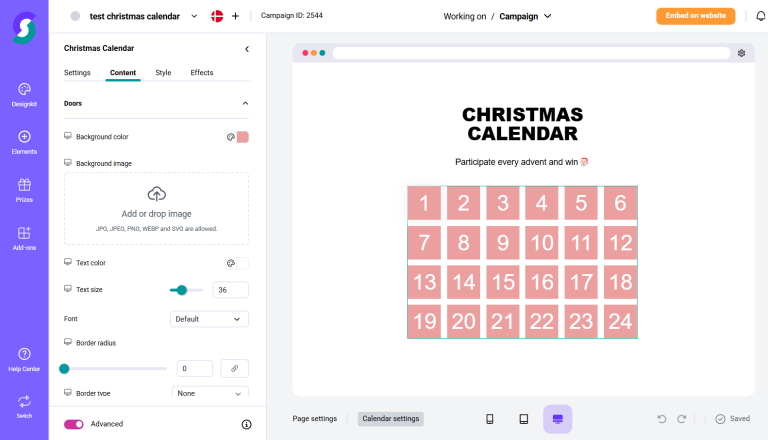
Implementation strategies:
On-Page Integration for Seasonal Landing Pages
Embed the Christmas Calendar directly into high-traffic landing pages to create a seamless holiday experience. Use a native embed or plug-in to ensure the calendar loads quickly and matches your site’s visual identity. Strategically place it above the fold or within product pages to guide users into daily engagement and incentivize repeat visits.
Email-Gated Entry for Lead Generation
Require users to sign up with their email (or phone number) to access the calendar. This approach turns engagement into qualified leads and enables remarketing throughout the holiday season. Use automated email sequences to remind participants to return daily, increasing retention and campaign visibility.
Multi-Channel Distribution with Daily Reveal Content
Promote each calendar day across multiple channels–social media, SMS, email, and even in-store signage. Sync the door reveal with your content calendar to create anticipation and maintain consistent visibility. Each day’s content can highlight giveaways, challenges, or exclusive discounts.
Gamified Pop-Ups for Daily Re-Engagement
Gamified pop-ups offer a dynamic way to boost daily engagement with your Christmas Calendar campaign. Unlike static pop-ups, these interactive elements can present daily challenges, mini-games, or prize draws tied to each calendar door. Designed to appear contextually–gamified pop-ups help remind users to return, play, and unlock new content. Their visual appeal and reward-based mechanics make them an effective tool for reinforcing daily habits, turning casual visitors into loyal participants throughout the festive season.
Ready to level up your engagement strategy?
Explore gamification marketing to create personalised experiences, foster engagement, and establish meaningful connections with your audience. With Scratcher as a partner you will have:
- 40+ Interactive Formats: Luck-based, knowledge-based, and skill-based, designed to meet marketing campaign objectives
- Ready to Use Templates: Personalise your campaign to reflect your unique brand
- User-friendly Integration: Easily integrate interactive content with all of your favourite marketing tools
- Customer Support: We're here to assist you every step of the way




